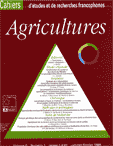Flowering peach trees of Vietnam: a successful combination of technical skills and cultural factors
Abstract
In developing countries, ornamental horticulture is usually export-oriented. In the vicinity of large towns in North Vietnam, flowering peach trees are produced for local markets only. They represent an interesting aspect of the temperate germplasm of Vietnam, and a special economic strategy is implemented. Very tiny fields can yield a high income, which has promoted the development of a real flowering peach industry, especially around the capital city of Hanoi. Red peach flowers (Photo 1) are essential for traditionally celebrating Têt, the Vietnamese New Year. This factor has led to the economic success of close-to-town horticulture. No parts of the overcrowded Red River delta area, close to West Lake in Hanoi, are wasted (Photo 2). The high retail price of flowering branches (15,000 to 20,000 dongs) and whole flowering trees (40,000 dongs) represents more than 10% of an average urban monthly salary. In the more market-oriented economy of present-day Vietnam, this high return has prompted high technical performance. Producers combine methods that are centuries-old with modern pest and disease treatments. Soil and climatic conditions are actually unsuitable for peach culture there. The excessive soil clay content (more than 30%) and high rainfall (1,800 mm/year) should rule out peach cultivation, which is highly susceptible to waterlogging. Any reasonable agro-economist would expect only rice production to be possible there. To overcome this problem, local growers have developed special drainage techniques (Photo 3) and orchard layouts (Photo 4). The work is all done manually, whereas buffaloes are used to cultivate the neighbouring paddy fields. One major variety, i.e. Bao Dich, has been cropped for centuries as its flowering coincides with the Têt celebrations and it has flowers with beautiful dark pink triple petals. Table 1 shows that the mean temperature of the coldest month (January) is 16.8° C, i.e. well above 7° C which is generally considered as the cold-hardening threshold for buds to overcome winter dormancy. This implies that Bao Dich is a peach with a low chilling requirement, which means that it is a genetic resource deserving close attention as no other local peach trees can be successfully grown at sea level at the low latitude of Hanoi (21° lat. N). Bao Dich could be used for breeding new tropical peach varieties, as there is high market demand for this fruit. Local techniques have been developed to help produce flowers at Têt-time and increase flowering intensity, i.e. girdling in September and leaf-stripping in November. A standard flower orchard is cultivated for 5-6 years. During the last 2 years, rooted trees are prepared for selling. The branches are artistically twisted and carved to give a "dragon-tail" look (Photo 6). The reasons for the lack of fruit on flowering peach trees have been investigated. The ovary, style and stigma have a normal morphology, but the pollen germination rate is very low (Table 2). The income yield per hectare has been estimated as ranging from 33 to 133 million dongs. This is much higher than income from rice, and even exceeds that from lichi production. There is an effective distribution network, using bicycles (Photo 7) for sales in the streets of Hanoi. In conclusion, the successful production of peach-tree flowers for local markets, combining adapted technology, local genetic resources and cultural factors, is a good example of the development potential of, for instance, other temperate fruits in Vietnam.Downloads
Published
1999-01-01
How to Cite
Blanchet, P., Ha, M. T. ., & Bourdeaut, J. (1999). Flowering peach trees of Vietnam: a successful combination of technical skills and cultural factors. Cahiers Agricultures, 8(1), 48–54 (1). Retrieved from https://revues.cirad.fr/index.php/cahiers-agricultures/article/view/30148
Issue
Section
Articles

